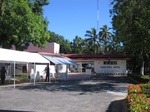It began during Spring Break 2007. Jim and Molly Conahan and their three teenagers – Megan, Matt and Brian – had taken advantage of non-stop airline tickets to fly to beautiful Zihuatanejo de Azueta, their favorite vacation spot on the Pacific coast of Mexico. One day, Jim and his kids left their resort and were wandering through Zihuatanejo’s outdoor market, when they noticed a number of local people who had been blinded by white cataracts.
The Conahans probably notice eyes more than most people, because Jim is a board-certified ophthalmologist who specializes in refractive surgery and micro-surgery of the eye, in Highlands Ranch, Colo., near Denver.
“Where do poor people here get eye care?” Jim’s kids asked.
When the Conahans discovered the nearest eye clinic for the poor was in Acapulco, 145 miles southeast of Zihuatanejo, Molly said to Jim, “We gotta do something. I think we should have a clinic. We can come back in October when the kids are on fall break.”
From impossible to…right on schedule

Jim had for years taken short-term trips to Mante, Mexico, with a group of his colleagues to perform free surgeries for people blinded by cataracts. He knew the difficulties involved in staffing, advertising and opening a free eye clinic, even if no surgery was involved. He knew there was no way it could happen by October, but he decided to humor his wife. “I’ll do this for Molly,” he thought.
Molly on the other hand, had been home with their three small kids during Jim’s annual trips to Mante. “It was as if God said, ‘You’ve been waiting for all these years. Now it’s your turn,’” Molly said. “It really just fell together.”
When they got in touch with the state social services department, Desarrollo Integral de la Familia (DIF), it turned out the woman they talked to had a cousin who lived in Mante. Her cousin knew all about the clinic there, which gave the Conahans instant credibility. Soon they were in touch with the local mayor, Silvano Blanco Deaquino, and his wife, Amalia, who ran the local DIF. Amalia soon reserved the naval hospital facility in nearby Ixtapa for the Conahans’ clinic, and promised to both spread the word and pre-screen prospective patients.
After they returned from their Spring Break trip, Jim started wondering how the five members of his family would fit 500 pairs of glasses, let alone other necessary equipment, in their luggage on the flight to Mexico. Meanwhile, he prepared his kids for disappointment, “The important thing is what’s in your heart. You could get down there and there’s nothing for you to do.”
The Conahans arrived in Zihuatanejo, supplies and all, right on schedule. The first morning of the clinic, they found 150 people waiting for treatment outside the naval hospital. On average, Jim’s new clients made about $80/month or about $2.67/day.
“I think it was a God thing,” Jim said. “In any other setting it would have taken years [to make the clinic happen].”
Matt manned the glasses table. Megan interpreted for Jim. (Having gone with Jim on one of his earlier trips to Mante, she had told him, “Dad, I’m going to become fluent in Spanish so I can be your interpreter.’”) Brian administered dilation drops, and Molly kept the clinic running smoothly. Over the course of three days, the Conahans saw more than 200 people in their clinic.
“The first 50 people in a row were blind from cataracts,” Jim recalled. “Technically, they had bilateral white cataracts.”
What Jim didn’t know was that his new patients were asking Molly when he was coming back to do surgery on their eyes, and Molly was answering, “Oh, he’s going to do it over Christmas.”
When Molly broke the news to Jim, he gaped, “Are you kidding me? You don’t even get how intense it is to do surgery and bring every piece of equipment.”
“Don’t worry,” Molly said. “It will all work out.”
Healed eyes for Christmas
“I’m asking myself, ‘Where am I going to get the equipment, a microscope, the proper instruments, and who’s going to want to help during Christmas? So I get back [home], and I’m about as tight as a guitar string,” Jim recalled. “Molly and I walk in to my office and say, ‘We’re doing surgery in Ixtapa in 6 weeks.’”
Erika Brown and Madeline Ponce, two technicians from Jim’s office, volunteered to help. “So okay, I had help,” Jim acknowledged. Knowing he’d also need another surgeon’s help, Jim got in touch with a friend from Texas A&M Health Science Center in Temple, Texas, who agreed to send a surgical resident if Jim paid his way.
Besides travel expenses, Jim knew each tray of surgical instruments would cost about $2,500, and he knew he would need four of them. He and Molly ended up spending $200 each for “used” trays through Surgical Eye Expeditions Intl.(SEE), a California-based non-profit that helps defray costs of doing surgery in developing countries. A few drug companies donated other supplies and Jim and Molly bought everything else they needed. Molly got condos donated in Zihuatanejo for their team of volunteers, and otherwise took care of the trip’s administrative details.
So in mid-December, Jim, Molly, Erika, Madeline, and the surgical resident from Texas A&M, known to the team and their patients as “Dr. Matt,” arrived in Zihuatanejo. With the help of Silvano, Amalia and the local DIF, they completed 50 cataract surgeries in four days.

One of those surgeries was for Martino, a 50-something man who had acid burn in one eye and a white cataract in another. Jim had originally declined to operate on Martino, because he didn’t want to risk what little eyesight Martino did have by doing surgery, but Martino’s situation weighed on Molly, who brought it up with Jim, and then it started weighing on Jim. They operated. After Martino’s sight was restored, he sobbed in gratitude.
“It was so out of both of our comfort levels,” Molly said. “But [Martino] had so many years of work ahead of him [that they couldn’t not do the surgery].”
“Coming to Ixtapa is like coming to another world,” Jim said. “It’s got its own dialect, it’s own stories…The people were so incredibly amazed that we would come down and do this that it then became apparent we could come more often. So we started a rotation of coming in May and October of every year.”
“They end up saving us”
On their trip in October 2009, Jim’s team of 24, including two other surgeons, performed 150 successful cataract surgeries in four days, saw about 500 people “in clinic,” and gave away 700 pairs of glasses.
Alejandro, 94, had his eyes screened during that clinic. Despite having cataracts in both eyes, he had made the three-hour bus ride from his village to Ixtapa with no assistance.
Jim recalled their post-surgery encounter, “He sat stoicly in his chair…We removed the patches. Megan asked, ‘Can you see?’ He just nodded, said ‘Yes.’ She says, ‘Are you happy with your vision?’ ‘Yes.’ ‘Is there anything you want to say to my father?’ ‘Yes,’…He stood up and only came up to about my chest. ‘Thank you for sharing what God meant for you to share.’ With that he turned around, walked out the door, got on the bus and went back to his village.”
“We go down there trying to help these people and they end up saving us,” Jim said. “We get so much more than they get. They’re very proud people. They don’t need our pity, they just need our help.”
Knowing they can’t meet all their patients’ eye care needs during their two bi-annual trips to Ixtapa, the Conahans have forged a partnership with Dr. Diego Dorega, a local ophthalmologist. If any of their patients need follow-up care during the year, they see Dr. Dorega.
While the Conahans’ work incorporates relationships from their local parish to Mexico and beyond, at its core it remains a family effort. Jim performs surgery, Molly serves as administrator, Megan interprets, Brian assists Jim in the operating room, and Matt works in the glasses clinic.
“We are just a normal family and look what God can do with us!” Molly said. “I thought the kids would be toddlers forever, and my only goal would be to clean peanut butter and jelly off the walls and clean up countless hot wheels and dolls off my floors.”

Last May, the whole family went to Ixtapa with a group of 20 mostly college-aged volunteers. Megan, then a senior at Creighton University, interpreted with two of her Spanish-speaking friends; Matt, then a freshman at St. John’s University (Minn.), distributed 2,000 pairs of glasses; Brian, then a junior in high school, helped in the OR; and Jim’s nephew and his fiancé, who are family practice physicians, oversaw the eye clinic.
The surgical team was booked solid and running low on supplies on the last day of planned surgeries, when a man in his sixties arrived at the clinic. Since it was so late in the week, the Conahans had already started scheduling surgeries for their upcoming October mission. The man from the mountains spoke no Spanish, so another Mexican translated for him, and Megan translated for the other translator. After hearing about the clinic, he had walked with his wife and daughter for two days straight from the mountains near Zihuatanejo. At first, the Conahans thought they would have to turn him away, but when another patient had second thoughts about her surgery, the “mountain man,” as everyone in the clinic called him, took her place. Jim removed one of the man’s cataracts, which turned out to have been on the verge of “leaking,” meaning it would have become inoperable and acutely painful had they not operated right away. They scheduled his other cataract to be removed in October.
“That touched everyone in the whole clinic,” Molly said. “Because we all thought we were done…It’s like giving your last piece of bread and you’re not sure you’ll have enough. But it came out absolutely perfect.”
Ixtapa and beyond
In 2008, word of their work reached Setan Lee, a survivor of Cambodia’s infamous “killing fields,” who asked Jim to take a surgical team to his hometown of Battambang, Cambodia. Jim initially felt it would be too much. “I said to Molly, ‘These pebbles in our shoe aren’t fair.’”
Nevertheless, Jim and Molly organized a meeting of 15 colleagues and friends from their parish to pray for and discuss the Cambodia question and gauge the interest of others in helping them expand their work into a new country. During the meeting, Sister Monique, an 84-year-old Catholic nun who survived the WWII killings in Thailand, said to Jim, “I think your mission should be called the ‘Mission of Healing Eyes’.”
So it was. Jim and Molly applied for and received non-profit status for the Mission of Healing Eyes.
In March 2008, Jim traveled with four others for 48 hours to get to Cambodia, then drove another six hours with eighteen 50-lbs. duffle bags full of sterilizers, implants, and other surgical supplies to get to Battabong, where they performed 35 cataract surgeries on local residents.
Due to ongoing unrest in Cambodia, the timing of future trips to Battambang is uncertain, but the Conahans will be in Ixtapa next month with yet another team of volunteers.
In the United States, the cost of cataract surgery is about $2,500. Through their growing team of volunteers, their partnership with SEE, and their relationships with local authorities, the Conahans do it at a cost (to them, not their patients) of about $50 per surgery.
First in Ixtapa, then in expanding to Battambang, Jim admitted, “It’s sort of just taken on a [life] of it’s own.”
To donate, to volunteer, or for more information about the Mission of Healing Eyes click HERE or email Jim and Molly.

